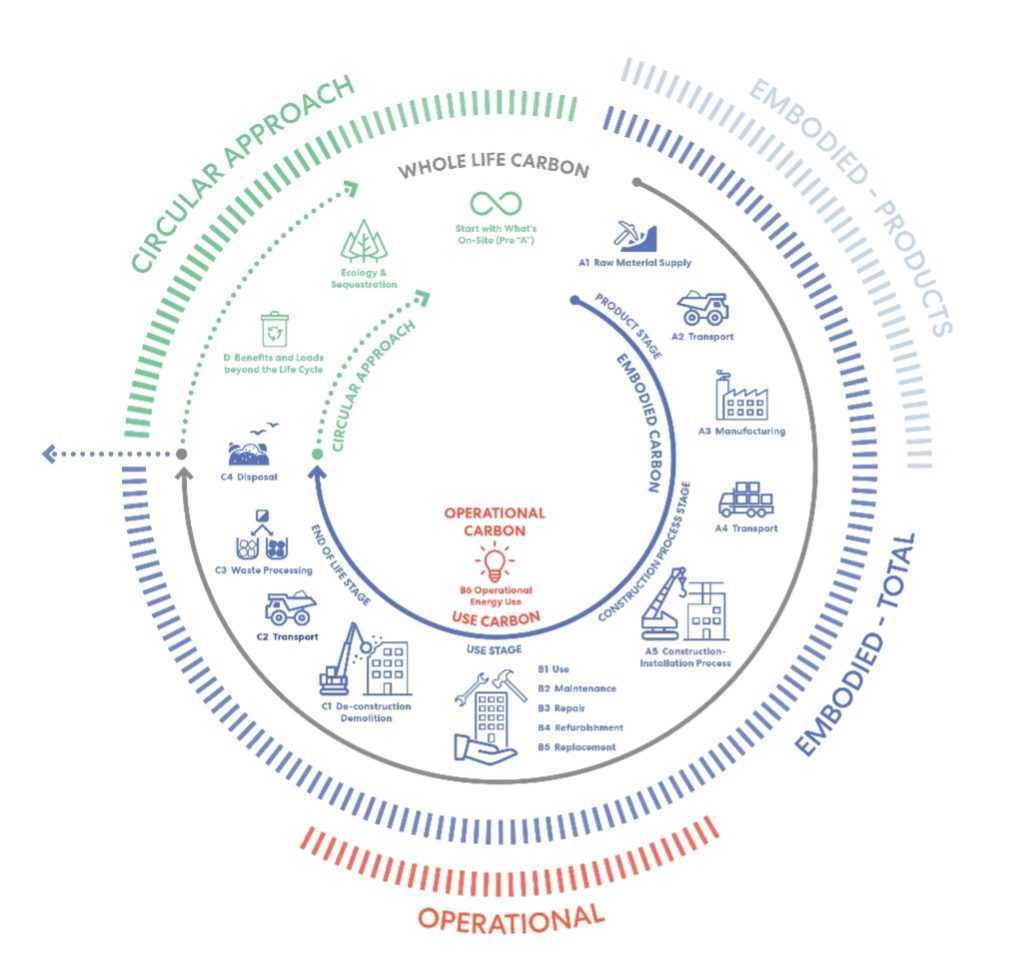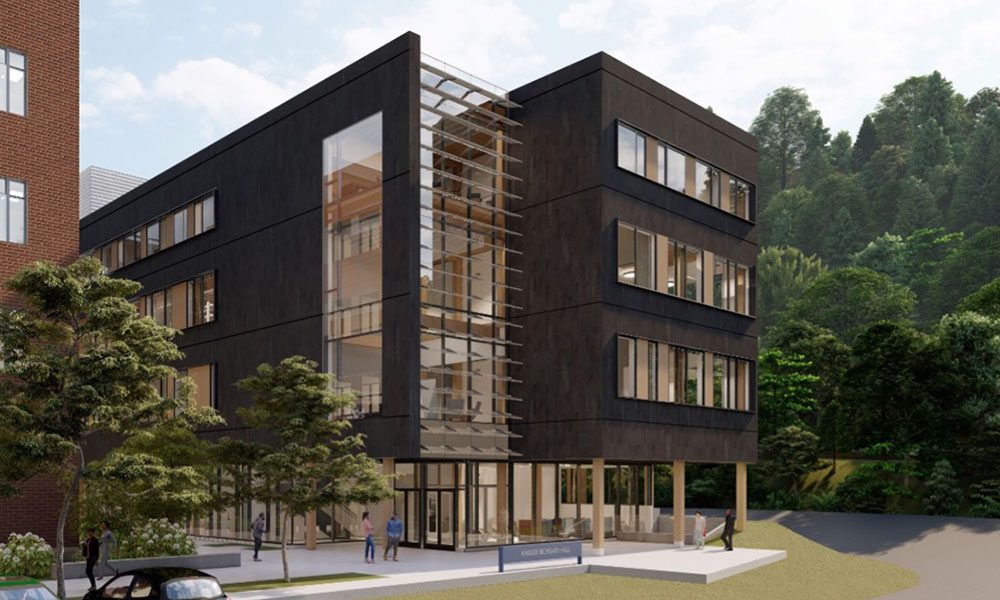Driving Down Carbon: Beyond Responsibility — to Action
by Kathy Wardle (left)
Principal & Director of Sustainability
Perkins&Will
& Mary Dickinson (right)
Associate Principal & Director of Sustainability,
Perkins&Will
June 15, 2022
Perkins&Will leaders urge bold collaborative change
Needs … and Questions
As we recover from a global health crisis, we must not lose sight of the urgent need to address climate change. In the wake of last year’s UN Climate Change Conference of the Parties (COP26) and the latest findings from the Intergovernmental Panel on Climate Change,1 global companies and governments are ratcheting up climate action commitments to find innovative ways to reduce greenhouse gas emissions across all sectors. But the question is: Are we moving fast enough to decarbonize the building sector? And how can we address climate health while also ensuring human health remains a priority?
For a decade, the architecture profession has been set on realizing zero operational carbon by 2030. But at COP26, the Glasgow Climate Pact called on countries to reach new, more aggressive goals by 2023 in a collective emergency effort to stop the planet’s temperature from climbing another 1.5 degrees Celsius (2.7 degrees Fahrenheit). Our charge, our responsibility, isn’t just coming up with a plan by 2023, it’s acting boldly — and now.
According to the World Green Building Council, the building and construction sector is responsible for 36% of global energy consumption, 38% of energy-related carbon emissions and 50% of resource consumption. It’s expected to double its total footprint by 2060.2 As architects and designers, we cannot deny our responsibility to guide our clients toward solutions that will reduce operational and embodied carbon. And we cannot postpone our efforts to balance this priority with other urgencies, such as protecting human health and well-being.
Understanding Carbon
While the desire to design a “zero” carbon building has become popular, we must be realistic about what this means — and what it entails. Carbon emitted over the entire life of a building is commonly known as whole-life carbon. Operational carbon refers to carbon emissions emitted during the use phase of a building. Embodied carbon refers to the greenhouse gas emissions arising from the manufacturing, transportation, installation, maintenance and disposal of building materials.3 The following diagram depicts these carbon life-cycle stages.
Over the last decade, great strides have been made in reducing building operational emissions, even with economic growth and expansion of the sector. Architecture 2030 reports that, while the U.S. GDP and building sector floor area increased by 26.2% and 18%, respectively, since 2005, building sector energy use and carbon dioxide emissions decreased by 1.7% and 21% in that time — despite the addition of 47 billion square feet of building stock.4 This scale of reduction in CO2 emissions reaffirms that our sector has the capability to execute low-carbon buildings while supporting economic growth.

Whole-Life Carbon Diagram. Image adapted from BS EN 15978:2011 “Sustainability of Construction Works — Assessment of Environmental Performance of Buildings — Calculation Method”, courtesy Perkins&Will.
A major driver for reductions in operational emissions is jurisdictions around the globe introducing stricter performance-based codes, as well as the decarbonization of the energy grid. The C40 Cities, a network of 100-leading metropolitan areas, is one example of how municipalities are deploying strategies to limit global heating to 1.5 degrees Celsius. These cities have committed to owning, occupying and developing assets that are net-zero carbon in operations by 2030.5 Additionally, the city of Vancouver has introduced a Zero Emissions Building Plan, setting performance-based targets for energy use, thermal energy demand and greenhouse gas emissions for all projects undergoing a rezoning. Other global cities, such as New York and London, have similar performance-based requirements aimed at driving down operational emissions.
Higher Standards
But even as we design buildings that perform better during their use phase, embodied carbon emissions in construction materials contribute a significant portion of whole-life carbon. Thus, there is urgency to address embodied carbon in design as well. Building upon its Zero Emissions Building Plan, Vancouver is also mobilizing to regulate embodied carbon: Effective in July 2023, all new buildings will be required to report embodied carbon performance and meet whole-building greenhouse gas intensity limits that include emissions from refrigerants. By 2025, performance-based thresholds will be mandated for the Vancouver building sector. Similarly, in the U.K., the Greater London Authority requires whole-life carbon assessment of projects over a certain size, and there is growing pressure to regulate embodied carbon in the UK’s national building regulations (Part Z).6
At the same time, many of our clients in all sectors are following suit. A growing body of clients is establishing climate action plans, reporting to investors on their Environmental, Social, and Governance (ESG) commitments, and/or becoming signatories of global commitments, such as the World Green Building Council’s Net-Zero Buildings Carbon Commitment,7 which sets a protocol for reducing whole-life carbon emissions from business operations.
In 2019, many Fortune 500 companies began setting climate action and carbon reduction targets.8 The most common targets included:
- Achieving carbon neutrality by completely offsetting greenhouse gas emissions.
- Setting a target for business operations to rely 100% on renewable energy
- Establishing a science-based target (SBT) that strives to reduce emissions in line with the need to keep global warming below 2 degrees Celsius.9
It can be argued that not all targets are equal, with SBT targets being the most rigorous and effective way to reduce greenhouse gas emissions in the atmosphere.
More recently, the U.S. Securities and Exchange Commission (SEC) proposed changes to disclosure requirements that would make information about companies’ direct greenhouse gas emissions public, specifically, (SEC’s Scope 1) and indirect emissions from purchased electricity or other forms of energy (SEC’s Scope 2), along with other climate-related risks.10
A Systems Approach
As regulatory authorities tighten policies, and as clients start to track and disclose their carbon emissions, we can help our clients meet their obligations through the design of low-carbon environments. To do so, we need to consistently employ a systems-based approach to maximizing whole-life carbon emissions reductions. This approach can include:
- Circularity: Uncovering ways to build less through building reuse, reuse of building materials and smart use of materials (so that they may be reused in the future).
- Passive Design: Exploring ways to reduce building energy demand through prioritization of the building orientation and envelope.
- Building System Optimization: Using energy efficient systems and equipment, and carefully considering fuel sources — including switching to clean fuel sources.
- Integration of Renewables: Designing for renewable energy systems, such as roof-mounted photovoltaics, building integrated photovoltaics, wind, etc.
- Offsets: Addressing any outstanding greenhouse emissions — only after all viable design measures have been implemented — by purchasing offsets to arrive at a net-zero carbon outcome.

Kaiser Borsari Hall for the Electrical Engineering and Computer Science programs at Western Washington University in Bellingham, WA. The science building is the first on campus to pursue both Net-Zero Carbon and Net-Zero Energy certifications through the International Living Future Institute (ILFI). Rendering image courtesy of Perkins&Will.
Using this framework, along with new and emerging industry-leading tools, we can facilitate conversations with our clients, forecast carbon conservation measures and unlock the potential of each new project. Such an approach and set of outcomes empowers each client to make carbon-informed decisions while considering material and system options. The worst thing we can do is neglect to have the conversation — or fail to attempt it.
While the need to reduce carbon emissions in the built environment is urgent, other priorities, such as designing healthy spaces, cannot be overlooked. Both should be addressed simultaneously, as they are synergistic and offer many co-benefits. For example, increasing outside air to improve indoor air quality does not necessarily mean increased operational energy. We can strike a balance by determining the volume of increased air we can obtain before increasing the size of our mechanical equipment. Similarly, in material selection, a well-insulated building optimizes a building’s energy performance, but blowing agents used in making or applying insulation can exponentially increase the product’s global warming potential. Other ingredients in insulation can introduce known toxins to human health, such as flame retardants or formaldehyde, which are carcinogens. Fortunately, a variety of high-performing insulation options are now available that can drastically reduce climate and human health impacts.
Obligation and Action
With a growing urgency to act boldly and decarbonize the building sector, architects and designers have a professional obligation to hasten our collective efforts. We are well-positioned to do this already — through the routine delivery of our services and by leveraging our skills and knowledge in sustainable design. We must implement the readily available tools to reduce the whole-life carbon of building operations and construction. Working in partnership with leading industry think tanks, scientists, researchers and, most importantly, our clients, we can help meet the most pressing needs of our planet.
Kathy Wardle, M.E.S., LEED Fellow, WELL AP, RELi AP — As principal and director of sustainability, Kathy plays an
instrumental role in the development of high-performance green building projects. She is currently advising on three large-scale projects
pursuing net-zero operational carbon design and managing a team of sustainable building design and energy advisers that offer clients a
range of sustainability services. Kathy is well versed in sustainability issues ranging from resilient design, energy and carbon
performance of buildings to the health and wellness of building inhabitants and co-chairs the firm-wide Living Design Leadership Council
and chairs Dar Group’s Sustainability Council.
Mary Dickinson, Associate AIA, RID, LEED AP® BD+C — As associate principal and director of sustainability, Mary has worked
on over five million square feet of sustainable design projects, many of which have been 2030 compliant. She managed the creation and launch
of Perkins&Will’s new transparency site and updated precautionary list. Fueled by her passion in refining the role and the impact of the
built environment on human and ecological health, Mary co-chairs the firmwide Living Design Leadership Council and sits on the research
board — roles that allow her the opportunity to respond quickly to the firm’s big ideas, share and apply them with in-house design teams.
FOOTNOTES:
1 Intergovernmental Panel on Climate Change, “IPCC
Sixth Assessment Report Mitigation of Climate Change”
April 4, 2022. — (back to article)
2 World Green Building Council — (back to article)
3 Carbon Leadership Forum, “Climate, Carbon,
and the Built Environment: The Impact of Buildings on Carbon Emissions.” — (back to article)
4 Architecture 2030, “Unprecedent Way
Forward,”
February 2020. — (back to article)
5 C40 Cities, “Net Zero Carbon
Buildings Declaration.” — (back to article)
6 Part Z — (back to article)
7 World Green Building Council, “The Net Zero Carbon Buildings
Commitment.” — (back to article)
8 & 9 Marcus Lu, “Visualizing
the Climate Targets of Fortune 500 Companies,”
June 3, 2021, Visual Capitalist. — (back to article)
10 U.S. Securities and Exchange Commission, “SEC
Proposes Rules to Enhance and Standardize Climate-Related Disclosures for Investors”
March 21, 2022. —(back to article)



